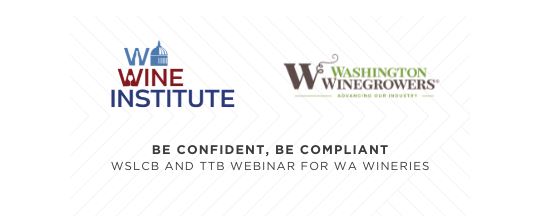Open Positions on the Washington State Wine Commission – Letters of Interest Due April 23
Attention: Washington State Wine Industry
The Washington State Wine Commission was created by the Washington State Legislature in 1987 to promote the growth of the wine industry. Its mission is to raise awareness and demand for Washington State wine through marketing and education, while supporting viticulture and enology research to drive industry growth.
The Commission was constituted under the Washington State Department of Agriculture and is governed by an appointed board of commissioners.
The Commission board is composed of twelve voting members and one non-voting member; five voting members shall be growers, five voting members shall be wine producers, one voting member shall represent the director of the Washington State Department of Agriculture and one voting member shall be a wine distributor. The non-voting member is a producer of non-vinifera fruit wine. Members serve three-year terms.
On June 30th the terms of four members of the Wine Commission board will expire: two producer and two growers. Candidates must meet qualification requirements as outlined below.
Appointments [RCW 15.88.050(1)]:
The director of the Washington State Department of Agriculture shall appoint the members of the commission. In making such appointments, the director shall take into consideration recommendations made by the growers’ association and the wine institute as the persons recommended for appointment as members of the commission. The director usually makes appointment selections in early May for a July 1, 2021 start to the 3-year term.
Positions expiring on June 30th are currently occupied by:
- Position #3 – Producer— Shylah Alfonso: Shylah will seek another term.
- Position #5 – Producer—Steve Griessel: Steve will seek another term.
- Position #8 – Grower—Sadie Drury: Sadie will seek another term.
- Position #10 – Grower —Brenton Roy: Brenton will not seek another term.
In accordance with RCW 15.88.030(1), the board seats mush be filled with candidates who meet the Mandatory Qualifications listed below. Additional requirements are as follows:
- The two producer positions (#3 & #5) have no additional requirements.
- The grower positions (#8 & #10) have no additional acreage requirements but must be filled by wine grape growers who do not produce and sell their own wine.
Pursuant to RCW 15.88.050, the Washington Winegrowers Association sends grower recommendations and the Washington Wine Institute sends wine producer and distributor recommendations to the Director of the Washington State Department of Agriculture for appointment consideration. The Director usually communicates appointments in May for a July 1, 2020 start to the 3-year term.
If you are an interested, qualifying wine producer, please submit your letter of interest and biographical information to WWI’s Executive Director, Josh McDonald, at josh@wwi.wine.
If you are an interested, qualifying grower, please submit your letter of interest and biographical information to the Washington Winegrowers Association Executive Director, Vicky Scharlau, at vicky@wawinegrowers.org
Candidates will be interviewed by the Association responsible for each open seat (reflected above) and recommendations made to the Director of Agriculture.
Commissioner Duties and Responsibilities:
- Active involvement in commissioner board meetings through regular attendance and engagement in discussions with meetings
- Represent and speak for the broader interest of the industry, not that of one’s own business nor that of any particular subset of the industry
- Have a clear understanding of the mission and be able to articulate its purpose and structure to the industry and general public
- Serve as an Ambassador for the Commission, educating the broader constituency about the Commission’s strategic direction and programming
- Be knowledgeable about industry trends
- Be available to serve on committees and attend Commission-sponsored event
- Be knowledgeable about state agency governance rules and regulations, i.e. Open Public Meetings Act, State Ethics laws, wine and grape assessment process, etc.
- Lead with intention, inclusiveness and equity.
- Have a desire and openness to learn and adapt to new ways of thinking as the wine industry grows.
Mandatory Qualifications [RCW 15.88.030(4)]:
Each member of the Commission must be a citizen and resident of the state and over the age of twenty-one years. Each member must be engaged in that phase of the growing or wine producing industry that he or she is appointed to represent, and during his or her term of office must derive a substantial portion of income from, or have a substantial investment in the growing of vinifera grapes or the production of wine from vinifera grapes as an owner, lessee, partner, or a stockholder owning at least 10% of the voting stock in a corporation engaged in the growing of vinifera grapes or wine production from vinifera grapes; or the manager or executive officer of such a corporation. These qualifications apply throughout each member’s term of office.
Desired qualifications:
- Strong grasp of marketing principles and tactics
- Strong understanding of the various wine marketing channels, including trade, media, distribution, and the consumer
- Collegial and collaborative approach to decision making and problem solving
- Strong leadership and management skills
- Strong communication skills
- Solid understanding of, a strong belief in the importance of, V&E research
- Global perspective of the wine business
- Extensive contacts and relationships throughout the industry and in the broader community (both within Washington and beyond)
- Strong record of participation or involvement in industry activities
- High level of integrity
Current Board of Commissioners includes:
- Steve Griessel, Betz Family Winery (winery)
- John Sportelli, Columbia Winery (winery)
- Casey McClellan, Seven Hills Winery (winery and grower)
- Brenton Roy, Oasis Farms (grower)
- Dan Werth, Ste. Michelle Wine Estates (winery)
- Sadie Drury, North Slope Management (grower)
- Dick Boushey, Boushey Vineyards (grower)
- Ryan Lumaco, Southern Glazer Wine and Spirits (wine distributor)
- Serena Roberge Gordon, Fletcher Bay Winery (non-vinifera producer
- Shylah Alfonso, Pomum Winery (winery)
- Rachel Horn, Aniche Cellars (winery)
- Lacey Lybecker, Cairdeas Winery (grower)
- Rianne Perry, Washington State Department of Ag (WSDA rep.)

 Member Login
Member Login


